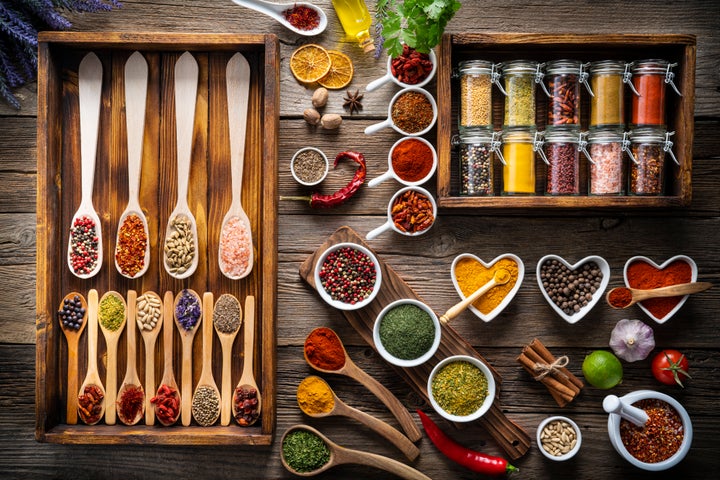
Whether you’re baking an apple pie, jazzing up a bowl of oatmeal, or making hummus or a pot of curry, spices are important ingredients that give a dish its unique flavor. Too little and spices go unnoticed and too much — well, you can ruin a recipe. Spices make a dish sing.
Although these minuscule ingredients may seem irrelevant, not only do they add plenty of pizzazz to a dish, but many spices have beneficial properties that are good for our health, too.
“Spices are high in antioxidants, and antioxidants fight free radicals that can wreak havoc in our bodies,” said Dr. Elizabeth Klodas, a preventative cardiologist in Minneapolis, Minnesota, and founder of Step One Foods, a food company to help patients make healthier eating choices to minimize a need for medication. “For heart health specifically, antioxidants help reduce the impact of elevated cholesterol levels,” she added.
But spices can do even more than that. According to Michelle Routhenstein, a preventive cardiology dietitian, “Spices can add several antioxidant compounds that can lead to a decrease in inflammation and a positive impact on cardiovascular health.”
And because spices increase flavor, they can reduce the need for salt. “Adding spices to your food is a great way to improve the taste of the food without adding salt or sugar,” said Dr. Nieca Goldberg, the medical director of Atria New York City and clinical associate professor of medicine at NYU Grossman School of Medicine. “Salt can raise blood pressure and worsen heart failure symptoms. Sugar can lead to weight gain and worsen glucose levels,” which can also put a strain on the heart, Goldberg said.
Looking to strengthen your heart health? Here are five spices experts recommend for heart health.
Cinnamon
Aromatic and sweet with peppery and woodsy notes, cinnamon is an essential baker’s ingredient and a common pantry staple, whether it’s for making a pumpkin pie, cinnamon rolls or to brighten up a bowl of oatmeal. “Cinnamon has been shown to help control blood sugar levels, especially in diabetics,” Klodas explained. “When you control blood sugar levels, there are secondary benefits from a cholesterol perspective — cinnamon lowers cholesterol and lowers triglycerides too, so it helps improve the cholesterol profile.”
Klodas loves to add cinnamon to her coffee, and she eats oatmeal in the winter and sprinkles in cinnamon. Goldberg added, “Cinnamon is a great way to sweeten oatmeal without adding sugar.”
Cumin
Cumin is used as both a whole seed and as ground powder and is a common addition in Indian cooking, but also tastes great to spice up Mexican dishes like beans or guacamole.
“Cumin is a heart-healthy spice because it contains flavonoids, a potent antioxidant that can help lower inflammation in the body,” Routhenstein said. “Cumin may also assist with weight loss and increase the release of bile from the liver to help digest fats.”
Curious how to incorporate cumin in your cooking? “Cumin has a nutty and warming flavor to it, and works well in bean dishes, stews and as a flavor enhancer to rice or quinoa,” Routhenstein suggested.
Garlic
Botanically speaking, garlic is a vegetable, but often gets grouped as a spice. After all, you’ll find garlic powder in the spice section at the grocery store. “Garlic has been shown to improve blood vessel flexibility and can lower cholesterol and triglyceride levels,” Klodas shared. Plus, it can reduce blood pressure, which is important for a healthy heart. “Garlic and other spices from the allium group are antioxidants and may have a role in lowering blood pressure,” Goldberg said.
But is there a difference between fresh and powdered garlic? In short, yes. “It is best to eat garlic in the fresh form, but if that is unavailable to you or it is more convenient in the dried form, you can still reap many of its benefits through the powdered form,” Routhenstein said.
A common ingredient for an array of savory dishes, this pungent bulb brings an abundance of flavor to any recipe. “Garlic features prominently in any savory dish — pasta sauces, soups, pesto, chilies ... ” Klodas said. She shared that when she’s making any of these types of dishes, she uses plenty of garlic.
Ginger
Ginger is a rhizome with a peppery and pungent flavor that brings a lot of aroma to both savory and sweet dishes as well as beverages, such as ginger tea, ginger ale and ginger beer. Similar to garlic, ginger is most pungent in its fresh form, but also comes dried and powdered.
“I would limit more processed forms of ginger like ginger ale or ginger beer due to its high levels of sugar,” Routhenstein advised. “Instead, choose to add fresh ginger in a smoothie or in your own herbal infusion, or use a ginger tea bag to reap its anti-inflammatory, GI-soothing benefits.”
“The active compound in ginger is gingerol, which has been shown to lower oxidative stress,” Routhenstein explained. “Oxidative stress can promote atherosclerosis and heart disease, and is typically present in excess in many heart conditions, and lowering it is advantageous for heart health.”
Curious how to use this versatile root in your cooking? “You can enjoy ginger in tea, pickled and added to your meal, in stir frys, or as a slightly peppery addition to your smoothie,” Routhenstein suggested.
Paprika
Paprika comes from grinding up dried red peppers, and it comes in different versions ― sweet, smoky and spicy.
“Paprika is a heart-healthy spice because of its rich vitamin A content,” Routhenstein explained. “It belongs to the beta carotene family, which is a potent carotenoid ― the pigment that gives paprika its bright color and provides an antioxidant boost to your food. Some studies show it may also help lower HDL cholesterol.”
The type of paprika you reach for will depend on what you’re cooking and your heat tolerance. “You can choose to select sweet, smoked or hot paprika depending on the dish and your flavor preference,” Routhenstein said. “The sweet paprika has a pinch of smokiness and pairs well on top of hummus, tofu, eggs and fish. The smoked paprika is sweet and smoky and offers a nice balance to bean and rice dishes.” And if you want to add kick to your meals, there’s hot paprika. “The hot paprika has a spicier kick and works well in soups, stews and braised dishes,” Routhenstein added.
Wondering if eating spices can have any negative side effects? Typically, there isn’t a need for concern. “When these spices are cooked in foods in normal small doses, there usually aren’t many contraindications,” Routhenstein said. “All spices are good for us in moderation. Although some people could have an allergy,” Klodas added. “Overdoing it, as with anything, can be problematic.”
Yet it’s important to consider which spices you’re consuming, especially if you’re on medication.
“We see the need to caution against certain spices like garlic, turmeric, ginger, paprika and cinnamon when individuals are on blood thinners and are ingesting large volumes of these spices, or using supplementation with these active ingredients,” Routhenstein warned. When making any changes to your diet, it’s always a good idea to speak with a health professional. “I would always consult with your registered dietitian who specializes in the condition to ensure optimal safety for you based on your medical conditions and the medications you are taking,” Routhenstein said.
